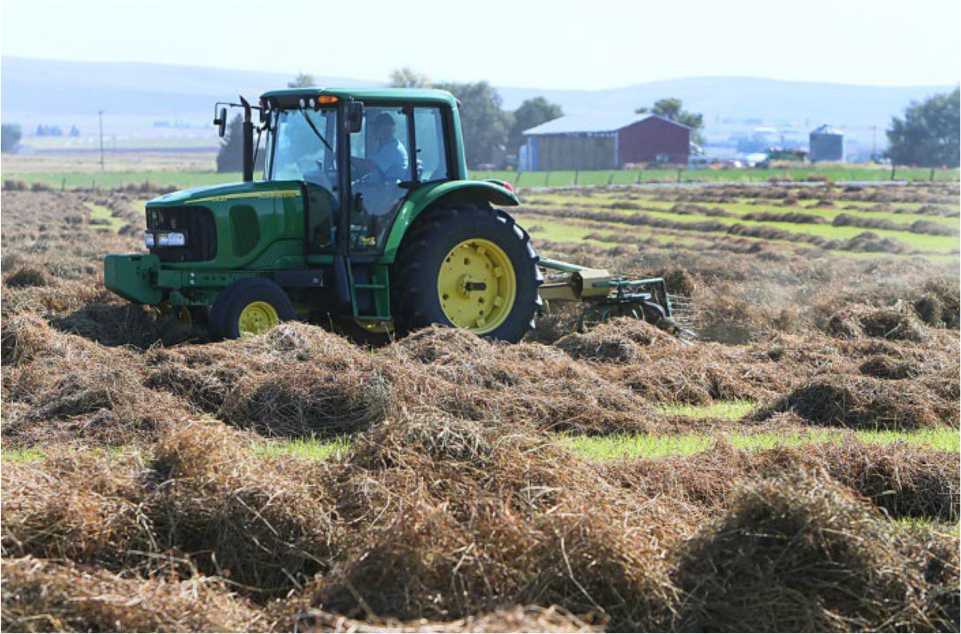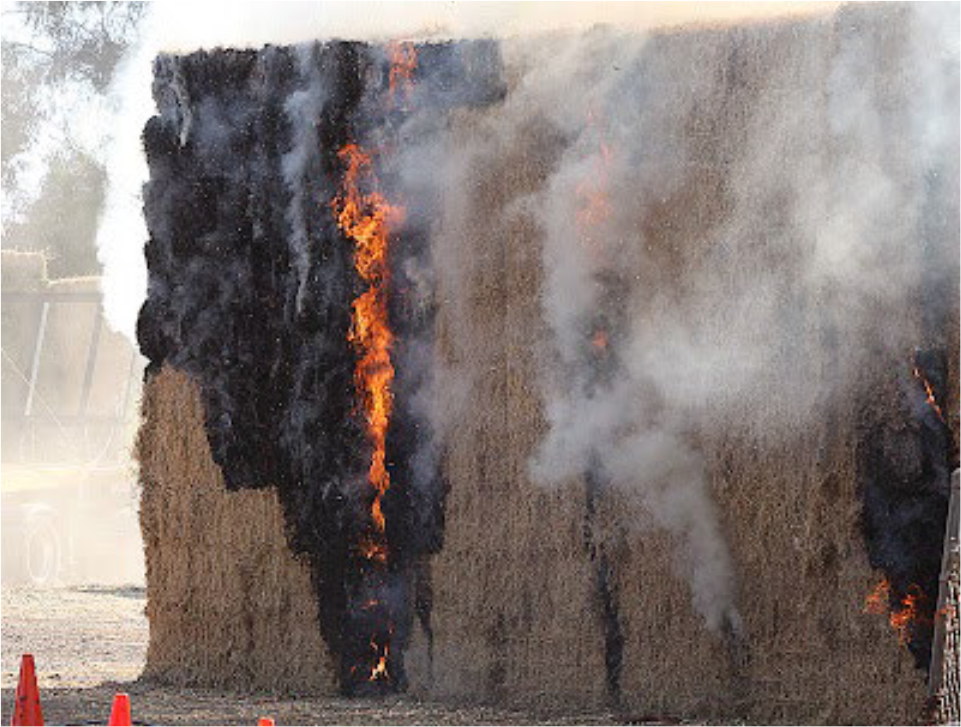⇦ Back to Crop Management Home
¶ Key Points
- Rain reduces yield and quality of harvested hay that is still in the field and on the ground. Field losses depend on rain intensity and duration.
- Wet hay encourages quality to deteriorate due to enhanced growth of microbes that metabolize the digestible components of the forage.
- Wet bales are at risk for combustion. Store appropriately and check internal temperatures. Anything above 170°F is high risk.
- Molds may produce mycotoxins. Feed moldy hay with caution. Make sure other clean feed is available.
- Wet bales will continue to lose quality in storage. Sample before feeding to adjust rations as needed.
- Test for routine nutrients. Suggest testing for heat-damaged protein and molds/mycotoxins as needed.
¶ A. Rain damaged hay
- Hay that has been cut, then rained on, often results in yield and nutritional quality losses
- Can lose 5% of dry matter for each inch of rain
- Potential digestibility losses of 10% or more
- Losses may be as high as 40%
- Longer duration rains increase losses
- Rain leaches cell solubles out of tissues
- Cell solubles are about half of dry matter leached by rain
- “Solubles” are highly digestible forage components
- Include highly water-soluble carbohydrates, vitamins, minerals, and lipids
- Highest leaching usually occurs when hay has partially dried, then followed by prolonged rain
- Rainfall occurring right after cutting usually has less nutrient leaching
- Leaching normally very low with quick “splash-and-dash” showers on freshly cut hay
- Slow, low intensity rains leach more than rapid, high intensity rains
- Cell solubles are about half of dry matter leached by rain
- Rain increases and prolongs active plant respiration
- Extended respiration results in forage nutrient loss and lower dry matter yield
- Occurs when hay is not allowed to dry sufficiently to stop plant’s metabolic processes
- Rain on green hay or partially dried hay allows respiration to continue for longer time
- Forage moisture content less than 30% begins to reduce respiration to acceptable levels
- Each rewetting by rain prolongs respiration
- Rain can increase leaf shattering
- Wet hay usually requires more mechanical handling to dry down
- Increased raking or tedding tends to shatter leaves from stems
- Leaves tend to dry more quickly than stems
- Hay quality and yield losses are due to leaf blade loss during raking and baling
- Leaf tissue contains more soluble nutrients stems
- Alfalfa leaf meal ≈ 60% TDN%[1]
- Alfalfa stems ≈ 47% TDN
- Wheat straw ≈ 43% TDN
- Moisture from rain enhances microbial breakdown of plant tissues.
- Plant tissue breakdown occurs when microorganisms begin to feed on downed hay
- Microbes develop rapidly in warm/moist conditions; feed on dead plant material
- Hay lying on the ground and remaining wet for extended periods becomes perfect environment
- Microbes can quickly destroy plant cell structure and consume plant nutrients
- Lower nutrient content results from loss of highly digestible cell solubles; e.g., sugars, minerals
- Digestibility decreases from increased insoluble fiber content; e.g., neutral detergent fiber, lignin
- Microbial activity will completely rot hay over time
- Destroy severely damaged hay?
- May be best to leave severely damaged hay in field.
- Chop with rotary mower to speed decomposition
- Destroying windrows minimizes shading and stunting of regrowing plants
¶ Figure 1. “Fluffing” Rain-Damaged Hay

(photo by B. Myrick, Ellensburg WA Daily Record)
¶ B. Heat-Damaged Hay
- Excess moisture lowers nutritional value of hay
- Includes wet hay in windrow, hay harvested with over 20% moisture, hay sitting in water, or hay that was otherwise saturated
- Wet bales continue to decrease in quality
- Hay ferments due to anaerobic conditions and heat
- Hot temperatures denature cell structures
- Changes protein and carbohydrate composition
- Affects nutritional quality
- Hay may “caramelize” in some cases
- Heating breaks down complex carbohydrates to simple sugars
- Sugars more easily oxidized
- Hay color becomes “caramel” colored; golden-brown to dark brown
- Usually has sweet smell
- Often has molasses-like or tobacco-like odor
- Hay is highly palatable, but lower quality
- Cell solubles are lost. ii. Insoluble fiber content increases
- Heating breaks down complex carbohydrates to simple sugars
¶ C. Hay combustion
- Spontaneous combustion
- Internal temperatures increase by “self-heating"
- Next step is “thermal runaway”.
- Self-heating that rapidly accelerates to high temperatures.
- Heat cannot be dissipated quickly enough
- May result in auto-ignition; i.e., hay catches fire
- Fires occur within two to six weeks of storage
- Most fires after four to five weeks of storage
- Excess moisture encourages microbial growth
- Dry hay restricts microbial growth
- Microbes include fungi (molds) and bacteria
- Desired harvest moisture is 20% or less
- 12% to 16% moisture is most desirable
- Microbial activity increases above 20% moisture.
- Microbes begin to digest and break down plant tissues.
- Produces heat in microbially active areas within bale.
- plant sugars + oxygen —> carbon dioxide + water + heat
- Increased risk of spontaneous combustion
- If weather conditions don’t allow drying and curing, use high-moisture baling or baleage techniques.
- Requires plastic wrap or tube to exclude oxygen.
- Creates anaerobic fermentation environment.
- Helps limit decomposition and heat production.
- Propionic acid-based preservative?
- Can reduce spontaneous heating within moist hays.
- Does not eliminate heating entirely.
- Results are not consistent.
- Affected by specific preservative formulation, equipment design, bale size, bale type, and storage management
- Results not favorable for large-round bales
- Consider strategies to eliminate heating; e.g., wrapping in plastic
- Store “hot” hay outside, away from other bales
- Limits risk of fire spreading to other locations
- Check insurance policies
- Some policies have coverage limits on number of bales per stack
- Check wet bale temperatures periodically
- Use long-stem compost thermometer
- Can drive metal pipe into bale; lower non-mercury thermometer through pipe
- Monitor any bales that reach 170°F or higher.
- Temperatures will likely continue to rise.
- Wet, hot bales continue to decline in quality.
- Bale combustion can begin at 190°F.
- Oxygen needed for combustion.
- Wet hay at 200°F can absorb twice as much oxygen as dry hay
- Combustion more problematic with coarse hays, like sorghum-sudangrass hybrids.
- Coarse stems increase oxygen flow inside bales. ii. Increased oxygen increases combustion risk
- Oxygen needed for combustion.
- Moving hot bales can increase combustion risk
- Opens up space between bales; increases oxygen flow
- Increased flow promotes combustion
¶ Figure 2. Haystack Fire Caused by Spontaneous Combustion

(https://glenn-snapshots.blogspot.com/2013/09/heat.html)
¶ D. Moldy hay
- Mold growth decreases quality.
- Molds use plant tissues as energy and protein source.
- Lowers feed value, reduces palatability.
- Molds may be present and not visible.
- Molds can produce “mycotoxins”.
- Mycotoxins are poisonous compounds or toxins that may be produced by various fungi.
- More than 400 individual mycotoxins have been identified.
- Only small number affect agricultural activities.
- Includes aflatoxin, zearalenone, T-2 toxin, etc.
- Presence or absence of mold does not directly indicate presence or absence of mycotoxins.
- Presence of mold does indicate possibility of mycotoxins.
- Watch livestock carefully for mycotoxin symptoms, if feeding moldy hay.
- Moderate mycotoxin levels can affect overall performance.
- Reduced intake, decreased rumen function, depressed production, .
- Livestock refusal may increase due to dust from spores or moldy odor.
- Increased potential for poor breed-up, lower conception rates, decreased calf weights
- High mycotoxin levels can be deadly, if ingested
¶ E. Feeding moldy hay
- Avoid moldy hay for horses.
- Are highly sensitive to mold.
- Danger of both respiratory and toxin issues.
- Limit amount of moldy hay for pregnant animals.
- Are more sensitive to mycotoxin poisoning.
- Can lead to fetal abortions.
- Spread out moldy bales when feeding.
- Let animals pick through hay.
- Animals will avoid badly molded chunks of hay.
- Have second source of clean hay available
- Ensures animals aren’t forced to eat moldy hay.
- Grinding moldy hay
- Dilute forages correctly in ration to ensure bad hay isn’t being overfed.
- Animals don’t have option to refuse bad hay.
- Mold can be human health risk.
- Avoid frequently inhaling large amounts of dust and mold
- Can cause respiratory issues (e.g., “farmer’s lung”)
- Advise wearing dust mask or respirator when working with moldy hay
¶ F. Hay testing
- Rain-damaged hay quality likely to continue declining after harvest.
- Quality decline slows when bales cool and moisture drops below 20%.
- Sample early to plan use of hay.
- Sample right before feeding to accurately assess quality and make final feeding management decisions.
- Suggest Roughage Test as minimum.
- Includes moisture, crude protein, acid-detergent fiber.
- Provides estimate of total digestible nutrients (TDN) and net energies.
- Test for “heat-damaged” protein (HDP).
- Analysis is for acid-detergent insoluble crude protein.
- Protein becomes associated with less digestible fiber fraction if hay is heated excessively.
- Does not contribute to dietary protein requirement.
- Is essentially “high bypass” protein.
- HDP bypasses digestion and is excreted.
- Testing moldy hay
- Testing for “mold spore count”.
- Spore counts can help identify general risk.
- Does not identify specific mycotoxins.
- Not exact relationship between spore counts and actual mold presence.
- Test first for vomitoxin?
- Vomitoxin also known as “DON (deoxynivalenol)”
- Is toxic at high levels
- Vomitoxin presence may be “marker” for potential presence of other, more toxic mycotoxins
- Testing for “mold spore count”.
[1] TDN = Total Digestible Nutrients
¶ References
Adams, et. al. 2016. Mold and Mycotoxin Problems in Livestock Feeding. PennState Extension, University Park, PA. https://extension.psu.edu/mold-and-mycotoxin-problems-in-livestockfeeding accessed 18Aug2023.
Beckman & Smith. 2019. What to Do with Wet Hay. BeefWatch e-news. Univ. of Nebraska Coop Ext., Lincoln NE. https://beef.unl.edu/beefwatch/what-do-wet-hay accessed 11Aug2023.
Bowes. 1984. Self-heating: evaluating and controlling the hazards. London: Department of the Environment, Building Research Establishment. ISBN 978-0-11-671364-3. pg. 376-390
Coblentz, et. al. 2013. Propionic Acid Preservatives for Hay. Focus on Forage, Vol 15: No. 5. Univ of Wisconsin Coop Ext., Madison WI. https://fyi.extension.wisc.edu/forage/propionic-acidpreservatives-for-hay/ accessed 18Aug2023.
Henning. Is rained-on hay any good? UK Ag Equine Programs. Univ. of Kentucky, Lexington KY. https://equine.ca.uky.edu/content/rained-hay-any-good accessed 14Aug2023.
Preston. 2016. 2016 Feed composition table. BEEF magazine. Farm Progress publications. https://www.beefmagazine.com/feed/2016-beef-feed-compostition-table-pdf-download 18 Aug2023.
Pugh. 2017. What is the effect of rain damage on hay? Ohio BEEF Cattle Letter, Ohio State Univ., Columbus OH. https://u.osu.edu/beef/2017/06/28/what-is-the-effect-of-rain-damage-on-hay/ accessed 15Aug2023.
Rankin & Undersander. 2000. Rain Damage to Forage During Hay and Silage Making. Focus on Forage, Vo. 2, No. 4. Univ. of Wisconsin Coop. Ext. Serv., Madison WI.
https://fyi.extension.wisc.edu/forage/files/2014/01/Raindam.pdf accessed 14Aug2023.
Walz. 2023. What are your options with wet hay? BEEF Daily e-newsletter.
https://www.beefmagazine.com/livestock-management/-what-are-your-options-with-wet-hay-
accessed 11Aug2023